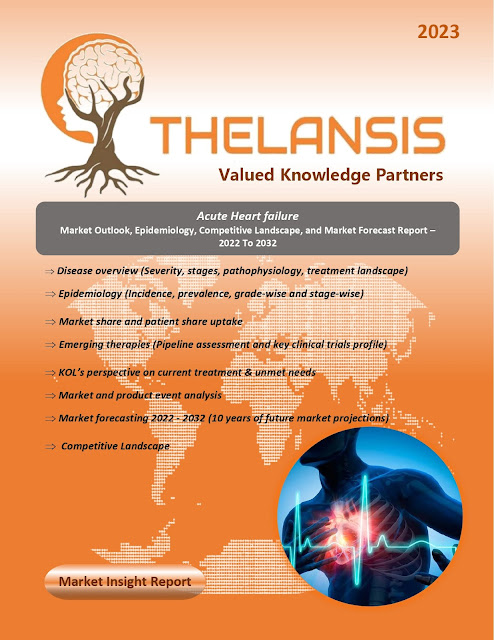Acute Heart Failure (AHF) – Market Outlook, Epidemiology, Competitive Landscape, and Market Forecast Report – 2022 To 2032
Acute heart failure (AHF) is the sudden onset or worsening of symptoms and signs associated with heart failure (HF). This critical condition typically requires hospitalization, focusing on the immediate management of fluid overload and compromised hemodynamics. It encompasses individuals experiencing typical HF symptoms and signs for the first time (de novo AHF) and those with exacerbated symptoms of their existing cardiomyopathy (acute decompensated heart failure). Heart failure (HF) is a clinical syndrome characterized by symptoms, including breathlessness, difficulty breathing while lying down, lower limb swelling, and signs such as elevated jugular vein pressure and lung congestion. These manifestations result from structural and functional abnormalities in the heart, leading to reduced cardiac output and increased pressures within the heart. More than 50% of patients in high-income regions and Eastern and Central European areas, acute heart failure admissions are primarily linked to ischemic heart disease. Globally, hypertension consistently contributes to the occurrence of heart failure. The most common HF symptoms include exertional or resting breathlessness, discomfort when lying flat (orthopnea), fatigue, and reduced exercise capacity. These symptoms are often accompanied by clinical signs such as limb swelling, distended jugular veins, a third heart sound called the "S3 gallop," and pulmonary rales. The European Society of Cardiology (ESC) classified heart failure patients into six groups based on their clinical presentations:
1. Acute
decompensated congestive heart failure involves worsening chronic heart
failure, characterized by a gradual onset of peripheral edema and significant
dyspnea.
2. AHF with
hypertension: This is marked by a rapid increase in systolic blood pressure,
pulmonary congestion, tachycardia, preserved left ventricular ejection fraction
(LVEF), and relatively low mortality.
3. AHF with
pulmonary edema: This presents with sudden or gradual severe respiratory
distress, widespread lung rales, tachypnea, orthopnea, and arterial oxygen
saturation (SaO2) below 90%.
4. Cardiogenic
shock: This is a highly fatal syndrome characterized by gradual or rapid organ
and tissue hypoperfusion, reduced urine output, and systolic blood pressure
below 90 mm Hg.
5. AHF
complicating acute coronary syndrome (ACS): This results from increased left
ventricular diastolic filling pressure or decreased cardiac output due to
myocardial ischemia or infarction.
6. Isolated
right-sided AHF: This is characterized by rapid or gradual edema onset, jugular
vein distention, hepatomegaly, clear lungs, low blood pressure, reduced left
ventricular filling pressure, and decreased cardiac output.
The first-line treatment for acute
heart failure is loop diuretics. These drugs include furosemide, bumetanide,
and torsemide.
·
The prevalence of heart failure is estimated
to be 6 million individuals, approximately 1.8% of the US population.
Thelansis’s “Acute Heart Failure (AHF)
Market Outlook, Epidemiology, Competitive Landscape, and Market Forecast Report
– 2022 To 2032" covers disease overview, epidemiology, drug utilization,
prescription share analysis, competitive landscape, clinical practice,
regulatory landscape, patient share, market uptake, market forecast, and key
market insights under the potential Acute Heart Failure (AHF) treatment
modalities options for eight major markets (USA, Germany, France, Italy, Spain,
UK, Japan, and China).
KOLs insights
of Acute Heart Failure (AHF) across 8 MM market from the centre of Excellence/
Public/ Private hospitals participated in the study. Insights around current
treatment landscape, epidemiology, clinical characteristics, future treatment
paradigm, and Unmet needs.
Acute Heart Failure (AHF) Market Forecast Patient
Based Forecast Model (MS. Excel Based Automated Dashboard), which Data Inputs
with sourcing, Market Event, and Product Event, Country specific Forecast
Model, Market uptake and patient share uptake, Attribute Analysis, Analog
Analysis, Disease burden, and pricing scenario, Summary, and Insights.
Thelansis Competitive Intelligence (CI) practice
has been established based on a deep understanding of the pharma/biotech
business environment to provide an optimized support system to all levels of
the decision-making process. It enables business leaders in forward-thinking
and proactive decision-making. Thelansis supports scientific and commercial
teams in seamless CI support by creating an AI/ ML-based technology-driven
platform that manages the data flow from primary and secondary sources.




Comments
Post a Comment